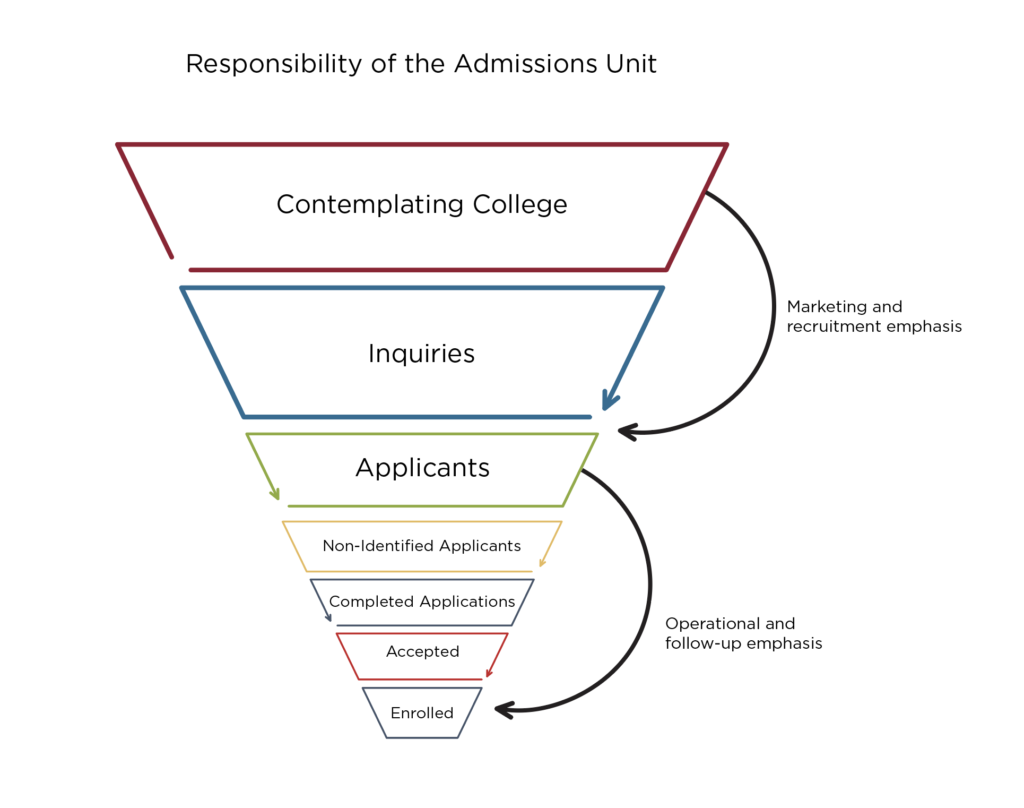
Stamats Insights
November 17, 2022
The enrollment funnel is a roadmap to understanding what or how to schedule communications. What you send to Leads is generally not appropriate messaging for Applicants, and messages for Applicants aren’t meant for Enrolled Students.
That makes sense, but higher ed marketers often get stuck on where to start. What are the right messages for each stage? And when should we start sending?
The answer? It depends on which stage you’re focused on and how your goals align with audience needs.

Start messaging for this group **right now**. These folks aren’t in your data set—they’re out there in the ether right now, scrolling the web and pondering their current and future life. They might be thinking:
You can reach this audience by creating blog stories, videos, and social posts that answer these questions. Your stories will plant the seed to get Contemplators thinking about making a change. It’s the softest of sells, and when they graduate to the Leads and Prospects stage, your brand will be top-of-mind.
Leads are sometimes referred to as prospects—who don’t necessarily know about your institution yet. They should be the largest data set for your communication plan. If it is currently the smallest, this is your sign to spend resources on widening your outreach to the Contemplators and growing your L&P list of students discovering your institution. Get tips on how to set up data sets for recruitment.
Messages for the L&P group should be about taking them along for a ride. Show them what you have to offer and make them crave engagement with your school. Key topics to hit on at this stage include:
If you want to dabble in some exploratory options and have a killer team, include L&Ps in campus activities, such as sporting events or theatre productions. Is your college hosting a summer camp? Send them an invite. This is a soft approach to get the student on campus and increase familiarity.
For key messages to current high school seniors or adult learners looking to start college, weaving in the above messaging will increase the urgency to apply. Remind them of key deadlines—such as when to file the FAFSA—to start building a relationship and position your institution as a trustworthy resource for information.
When a potential student has reached this level, they know about your school and have raised their hand to engage with you. So, messages for this group are a little more specific. The data sets on these students are more robust than leads. For example, you might have an idea what program they are interested in and may also have their parent or family member contact information.
Your communication plan for Inquiries should focus on key elements of what a student needs to know to choose your school, such as:
If a student is a senior in high school, include a link to apply with each message. No one can entirely predict when a student will convert to the next stage, so it’s best to keep that link handy. High-performance students tend to make decisions early in the year. Go ahead and send a mailer in early August to increase awareness of your college or university as a precursor to your digital communications.
If a student is a junior in high school, be careful about including links to apply. Generally, institutions do not enroll students younger than 17. There are exceptions to the rule, such as accelerated students. And if you think they are in your pool for communications, then it is wise to review your data on their anticipated start year. Messages to this audience should focus on visiting campus and taking them on a journey into the next recruitment year when they can apply. Topics are the same as for seniors but the call-to-action may be different, depending on the message.
When to include parents or guardians: For Inquiries ages 15-19, include key family members who typically help with college options. Regulations for digital communication such as email or text have parameters about who your school can “talk” with, and including parents early helps with meeting regulations. Positioning yourself as the expert on college admission information builds trust with family members, which can make your school their go-to for resources.
The applicant pool has three phases to build communication around, each with specific messaging to help coach the applicant along in the process:
Not submits need information about completing their application. This is akin to an online retailer saying, “you left something in your cart.” Your messages should prompt the individual to complete and submit their application. These messages usually have a specific link not found on the website for the student to access and complete the application.
Often institutions do not include this phase in their communications, yet it is a crucial step for students. A client of ours recently discovered that students were struggling to complete a profile that was tied to authentication. By fixing that issue, they could provide a useful link to log in and complete the process. This simple communication can easily increase yield each term.
File incompletes should receive a confirmation message with crucial next steps after submitting their application. This is an excellent step to include in the admissions checklist as a dynamic webpage or PDF with steps to complete. Each step on the checklist should have a link to click and complete.
The checklist is a great tool to build emails that are specific to key steps. For instance, if a student needs to submit seventh-semester transcripts, send an email about that step. Include the link to the checklist if they complete this step and are ready for the next one. Send the next message about submitting their medical history and where to submit it, such as the student health center.
Monitor your communications at this stage and watch the engagement. If certain messages are not opened or clicked, they may need to be reworked, folded into another message, or eliminated.
Decision made is the final leg of the applicant’s journey. Here, messaging takes another turn and starts talking about steps one must take to be ready for class. This includes messages like:
Once a student has completed these steps and made it through the admission process, communication is about reminders and keeping the student engaged. If you use an app, make sure students are receiving messages and engaging with it to get the most recent information.
Some institutions send acceptance packets. This is a great opportunity to engage the student on social media and invite them to closed groups centered around new students or family members. Use this opportunity to send a poster with a hashtag about starting college and encourage them to post to their favorite social channel to help build organic positive postings on your school’s site.
After move-in and the first day of classes, continue the conversation to keep students engaged. General messaging to this audience can include available services, such as student health and tutoring. Send messages, post on social media, and hang flyers on campus about events, clubs, and other activities—don’t let up on the brakes at this stage.
The percentage of students who do not return after the first term or semester is staggering. Continuing to engage and keep students in the loop about events and activities can help them find their place at your school.
Continuing to engage with each phase of the enrollment funnel is imperative to your headcount on the first day and the fourth week of school. Schools that become complacent with matriculated students are missing a key opportunity to engage more.
Review your data. Take inventory of the size of groups and make business decisions accordingly. Find the holes in your communication and provide information in small bites as a potential student moves through the college or university’s recruitment cycles. Then check your engagement rates and adjust the message or plan. Rinse and repeat.
We’d love to help you develop your strategy, build a communication plan, or optimize your enrollment campaign. Connect with Marianne Sipe to learn more about accelerating your enrollment growth.
Ready to Get Started?
Reach out to us to talk about your strategy and goals.